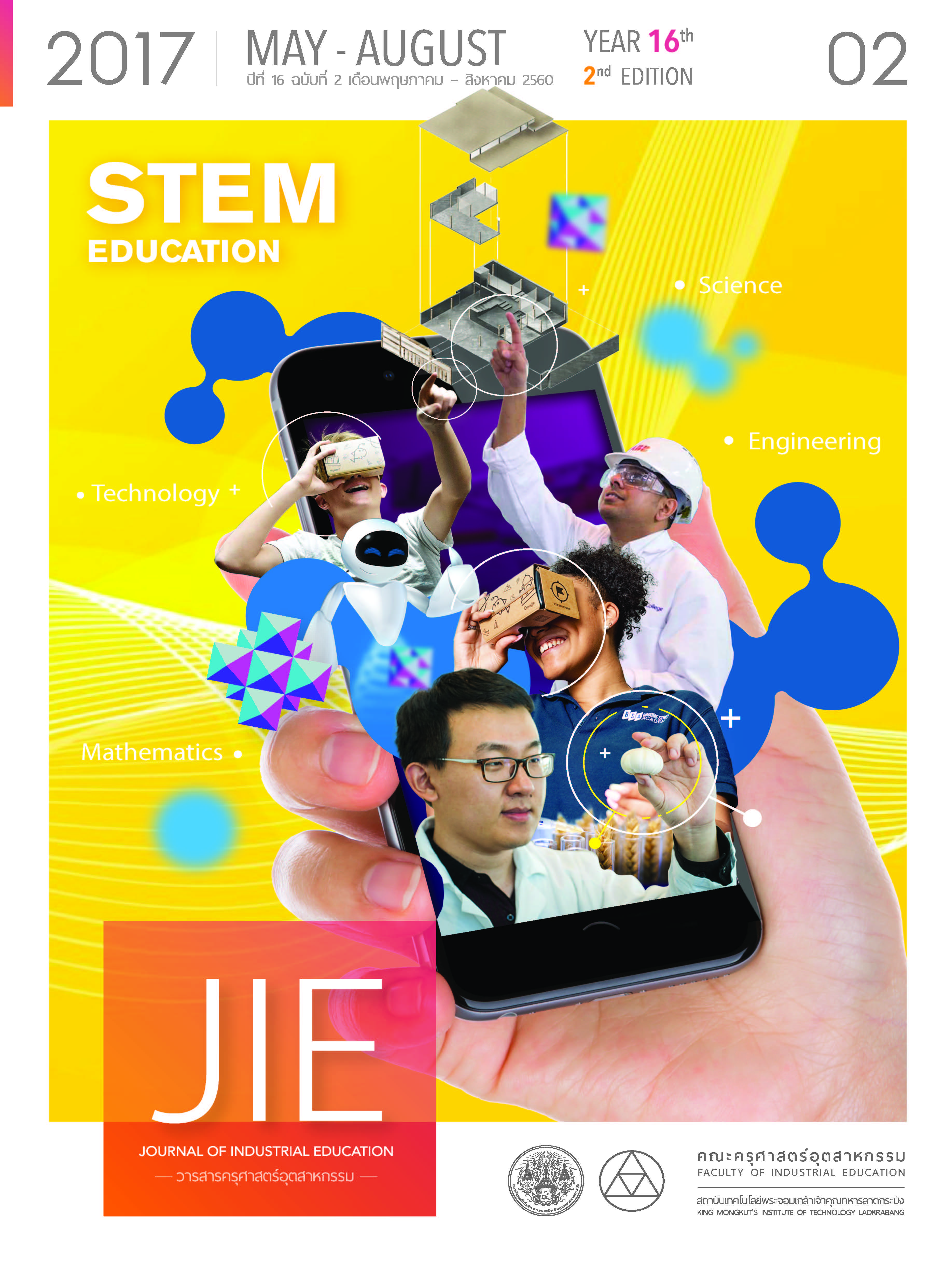การพัฒนาหนังสืออิเล็กทรอนิกส์ เรื่องการจัดองค์ประกอบการถ่ายภาพ ระดับประกาศนียบัตรวิชาชีพ
คำสำคัญ:
การพัฒนา, หนังสืออิเล็กทรอนิกส์, การจัดองค์ประกอบ, การถ่ายภาพ, ประกาศนียบัตรวิชาชีพบทคัดย่อ
การวิจัยครั้งนี้มีวัตถุประสงค์ 1) เพื่อพัฒนาหนังสืออิเล็กทรอนิกส์ เรื่อง การจัดองค์ประกอบการถ่ายภาพ ระดับประกาศนียบัตรวิชาชีพ ที่มีคุณภาพและประสิทธิภาพ และ 2) เพื่อเปรียบเทียบผลสัมฤทธิ์ทางการเรียนของนักเรียนก่อนเรียนและหลังเรียนด้วยหนังสืออิเล็กทรอนิกส์ เรื่อง การจัดองค์ประกอบการถ่ายภาพ กลุ่มตัวอย่างเป็นนักเรียนประกาศนียบัตรวิชาชีพ ชั้นปีที่ 3 ปีการศึกษา 2559 วิทยาลัยเทคโนโลยีไทยวิจิตรศิลป ได้มาด้วยการสุ่มตัวอย่างแบบกลุ่ม ได้แบ่งเป็น 2 กลุ่ม จำนวน กลุ่มละ 50 คนคือ กลุ่มที่ 1 เพื่อทดลองหาประสิทธิภาพของหนังสืออิเล็กทรอนิกส์ และ กลุ่มที่ 2 เพื่อศึกษาผลสัมฤทธิ์ทางการเรียน เครื่องมือที่ใช้ในการวิจัย ประกอบด้วยหนังสืออิเล็กทรอนิกส์ เรื่อง การจัดองค์ประกอบการถ่ายภาพ แบบประเมินคุณภาพหนังสืออิเล็กทรอนิกส์ และแบบทดสอบวัดผลสัมฤทธิ์ทางการเรียน ที่มีค่าดัชนีความสอดคล้อง ระหว่าง 0.67 - 1.00 ค่าความยากง่ายระหว่าง 0.20-0.80 ค่าอำนาจจำแนกระหว่าง 0.20-0.70 และค่าความเชื่อมั่นเท่ากับ 0.86 วิเคราะห์ข้อมูลโดยใช้สถิติ ค่าเฉลี่ย ค่าเบี่ยงเบนมาตรฐาน และสถิติทดสอบที (t-test for dependent samples) ชนิดสองกลุ่มไม่เป็นอิสระต่อกัน
ผลการวิจัยพบว่าหนังสืออิเล็กทรอนิกส์ เรื่อง การจัดองค์ประกอบการถ่ายภาพ มีประสิทธิภาพเท่ากับ 88.40:87.33 เป็นไปตามเกณฑ์ที่กำหนดคือ 80:80 และ ผลสัมฤทธิ์ทางการเรียนด้วยหนังสืออิเล็กทรอนิกส์ เรื่อง การจัดองค์ประกอบการถ่ายภาพ หลังเรียนสูงกว่าก่อนเรียนอย่างมีนัยสำคัญทางสถิติที่ระดับ 0.05
เอกสารอ้างอิง
[2] Niyomsritrang Apirattanapan. 2011. The level of creativity in the composition of photos derived from practice, visualization by self-portraiture, and how to practice visualization with computer software. Masterdegree of Educational Technology, Burapa university.
[3] Wanjana Erawan. 2010. Development of electronic books on science projects. Environment for Prathomsuksa 5 students. Masterdegree of Curriculum and instruction, Rajamangala University of Technology Under the patronage.
[4] Taworn Noonraaor. 2007. The development of electronic books on the human body.Science Learning Group for Prathomsuksa 6 Students. Masterdegree of Department of Technology and Communication Education, Chandrakasem Rajabhat University.
[5] Seels, B., & Glasgow, 1998. Making Instructional Design Decisions. (2nd ed.) Upper Saddle River, NJ : Merrill.
[6] Chaiyong Promwong. 1999. Teaching media system. Bangkok : Chulalongkorn Printing House.
[7] Pornchanok Sownburi. 2013. Development of electronic books (e-books) for education. Faculty of Humanities and Social Science.
[8] Thanakrid Tuptimsuk. 2015. E-book development: photography techniques. Educational Technology Faculty of Education, Burapa university.
[9] Nattapon Tanakeagsakun. 2012. Development of electronic lessons on the technological cycle. Journal of Industrial Education. 11(3), p.40-47
[10] Tummanoon Kaseamsriwittaya. 2014. Electronic lessons for review of basic programming. For microcontroller PICS. Journal of Industrial Education. 13(2), p.153-158
[11] Aorrasa Panitjareanpon. 2013. Development of electronic books on information and communication technology For Mathayom Suksa 1 students Under the jurisdiction of the Office of the Secondary Education Service Area 17 in Trat Province. Master degree of Major in Education and Teaching, Rajabhat Pannee University.
[12] Aorrawan Anuwipa. 2011. Development of Thai electronic books in Thai mainstream. For Prathomsuksa 5 students. Journal of Physical Education. 3(3), p.111-126.
ดาวน์โหลด
เผยแพร่แล้ว
รูปแบบการอ้างอิง
ฉบับ
ประเภทบทความ
สัญญาอนุญาต
"ข้อคิดเห็น เนื้อหา รวมทั้งการใช้ภาษาในบทความถือเป็นความรับผิดชอบของผู้เขียน"



